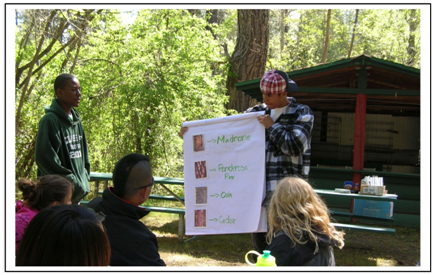4-H Delivers
4-H On the Wild Side
The Issue:
There is a well-recognized need to improve youth scientific literacy in California. In addition, getting kids outdoors to explore natural environments in the context of a supportive youth development program is also essential. In Sacramento County, efforts to connect youth with outdoor environments and science education resulted in the development of an overnight camp experience, 4-H On the Wild Side.
What has 4-H Done?:
On the Wild Side is an overnight environmental education program for students in Sacramento’s low-income communities. A team of teens and adults plan and deliver the program which is held over two weekends towards the end of the school year. The On the Wild Side program wanted to continue to increase knowledge about the environment, but also include the experience of “doing science.”
The 4th-6th grade campers rotated through five teen-led educational sessions, shared meals and songs around the campfire, and interacted with the natural world in ways not possible in the city. All activities at On the Wild Side were experiential and encouraged exploration and deductive thinking. The 4-H Science, Engineering, and Technology (SET) abilities were emphasized by the trainers, especially making observations and allowing the campers to analyze and reason. Youth participated in 5 different activities. They tested water samples throughout the weekend for temperature, pH, turbidity, and salinity. They then analyzed and reasoned why the measurements did or did not vary. They studied trees as habitats and looked for evidence of how the animals use the trees. Campers participated in a game simulating animal population dynamics based on habitat and had to interpret the rise and fall of the population and how the availability of food, water, and shelter affected the population. Youth learned about different types of rocks and then gathered and analyzed their collection. Campers explored how habitat can be preserved and where, in their own communities, it has been altered. They participated in a simulation modeling the relationship between producers, herbivores and carnivores, and the impact development has had on loss of habitat and the food chain.
The Impact:
Since its inception in 2000, On the Wild Side has demonstrated consistent outcomes in student learning and teen leadership. The teen leaders were effective teachers in helping younger students learn about the environment. The youth came away with a better understanding of the relationship between habitat and living organisms, an increased vocabulary, and more information about ecosystems. The teens were responsible for engaging in teamwork, working with children, organizing and delivering presentations, and writing and submitting grants.




